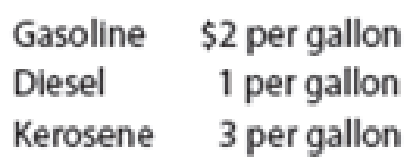
Managerial Accounting
15th Edition
ISBN: 9781337912020
Author: Carl Warren, Ph.d. Cma William B. Tayler
Publisher: South-Western College Pub
expand_more
expand_more
format_list_bulleted
Textbook Question
Chapter 5, Problem 17E
Joint cost allocation-market value at split-off method
Toil & Oil processes crude oil to jointly produce gasoline, diesel, and kerosene. One batch produces 3,415 gallons of gasoline, 2,732 gallons of diesel, and 1,366 gallons of kerosene at a joint cost of 112,000. After the split-off point, all products are processed further, but the estimated market price for each product at the split-off point is as follows:

Using the market value at split-off method, allocate the $12,000 joint cost of production to each product.
Expert Solution & Answer
Want to see the full answer?
Check out a sample textbook solution
Students have asked these similar questions
Kindly help me with general accounting question
Solve this question financial accounting
The following financial statement information is from five separate
companies.
Beginning of year
Assets
Liabilities
Compan Compan Compan Compan Compan
УА
y B
ус
y D
y E
$ 55,000 $34,000 $24,000 $60,000 $1,19,00
24,500 21,500 9,000
40,000 ?
End of year
Assets
Liabilities
Changes during
58,000
40,000 ?
85,000 1,13,000
?
26,500
29,000
24,000 70,000
the year
Owner
6,000
1,400
9,750 ?
6,500
investments
Net income (loss)
8,500 ?
8,000
14,000
20,000
Owner
3,500
2,000 5,875
0
11,000
withdrawals
Compute the amount of liabilities for Company E at the beginning of the
year.
End of the year
Assets
= Liabilities +
Equity
$ 1,13,000 =
$ 70,000 +
$ 43,000
Statement of Owner's equity
Equity, beginning of year
$ 43,000
Add: Investment by owner
6,500
Add: Net Income
20,000
69,500
Less: Withdrawal by owner
11,000
Equity, end of year
?
Chapter 5 Solutions
Managerial Accounting
Ch. 5 - Why are support department costs difficult to...Ch. 5 - Why does support department cost allocation matter...Ch. 5 - What are some drawbacks of applying support...Ch. 5 - Why is the diect method of support department cost...Ch. 5 - How does management determine the order in which...Ch. 5 - Are large or small companies more likely to use...Ch. 5 - What is the main difference between the physical...Ch. 5 - When would management most likely use the net...Ch. 5 - What are the two most often used ways of...Ch. 5 - How can support department and joint cost...
Ch. 5 - Charlies Wood Works produces wood products (e.g.,...Ch. 5 - Bucknum Boys, Inc., produces hunting gear for buck...Ch. 5 - Prob. 3BECh. 5 - Blakes Blacksmith Co. produces two types of...Ch. 5 - Garys Grooves Co. produces two types of carving...Ch. 5 - Prob. 6BECh. 5 - Yo-Down Inc. produces yogurt. Information related...Ch. 5 - Prob. 2ECh. 5 - Blue Africa Inc. produces laptops and desktop...Ch. 5 - Christmas Timber, Inc., produces Christmas trees....Ch. 5 - Crystal Scarves Co. produces winter scarves. The...Ch. 5 - Davis Snowflake Co. produces Christmas stockings...Ch. 5 - Prob. 7ECh. 5 - Prob. 8ECh. 5 - Prob. 9ECh. 5 - Support department cost allocation comparison...Ch. 5 - Prob. 11ECh. 5 - Prob. 12ECh. 5 - Joint cost allocation market value at split-off...Ch. 5 - Joint cost allocation net realizable value method...Ch. 5 - Prob. 15ECh. 5 - Prob. 16ECh. 5 - Joint cost allocation-market value at split-off...Ch. 5 - Joint cost allocation net realizable value method...Ch. 5 - Support department cost allocation Blue Mountain...Ch. 5 - Support activity cost allocation Jakes Gems mines...Ch. 5 - Joint cost allocation Lovely Lotion Inc. produces...Ch. 5 - Joint cost allocation Florissas Flowers jointly...Ch. 5 - Support department cost allocation Hooligan...Ch. 5 - Support activity cost allocation Kizzles Crepes...Ch. 5 - Joint cost allocation McKenzies Soap Sensations,...Ch. 5 - Prob. 4PBCh. 5 - Analyze Milkrageous, Inc. Milkragcous, Inc., a...Ch. 5 - Analyze Horsepower Hookup, Inc. Horsepower Hookup,...Ch. 5 - Prob. 3MADCh. 5 - Prob. 4MADCh. 5 - Joint cost allocation and performance evaluation...Ch. 5 - Prob. 3TIFCh. 5 - Prob. 1CMACh. 5 - Adam Corporation manufactures computer tables and...Ch. 5 - Breegle Company produces three products (B-40,...Ch. 5 - Tucariz Company processes Duo into two joint...
Knowledge Booster
Learn more about
Need a deep-dive on the concept behind this application? Look no further. Learn more about this topic, accounting and related others by exploring similar questions and additional content below.Similar questions
- Hii expert please given correct answer general Accountingarrow_forwardWIP DIV 2 has the following information: Beginning Units 9,100 Units Started 48,000 10,500 Ending Units Conversion costs are 40% complete with regards to ending WIP beginning conversion costs = $92,000. Conversion costs added during the current accounting period = $222,960. What are conversion costs allocated to units transferred out?arrow_forwardI need this question answer general Accountingarrow_forward
arrow_back_ios
SEE MORE QUESTIONS
arrow_forward_ios
Recommended textbooks for you
 Managerial AccountingAccountingISBN:9781337912020Author:Carl Warren, Ph.d. Cma William B. TaylerPublisher:South-Western College Pub
Managerial AccountingAccountingISBN:9781337912020Author:Carl Warren, Ph.d. Cma William B. TaylerPublisher:South-Western College Pub Principles of Cost AccountingAccountingISBN:9781305087408Author:Edward J. Vanderbeck, Maria R. MitchellPublisher:Cengage Learning
Principles of Cost AccountingAccountingISBN:9781305087408Author:Edward J. Vanderbeck, Maria R. MitchellPublisher:Cengage Learning Financial And Managerial AccountingAccountingISBN:9781337902663Author:WARREN, Carl S.Publisher:Cengage Learning,
Financial And Managerial AccountingAccountingISBN:9781337902663Author:WARREN, Carl S.Publisher:Cengage Learning, Managerial Accounting: The Cornerstone of Busines...AccountingISBN:9781337115773Author:Maryanne M. Mowen, Don R. Hansen, Dan L. HeitgerPublisher:Cengage Learning
Managerial Accounting: The Cornerstone of Busines...AccountingISBN:9781337115773Author:Maryanne M. Mowen, Don R. Hansen, Dan L. HeitgerPublisher:Cengage Learning

Managerial Accounting
Accounting
ISBN:9781337912020
Author:Carl Warren, Ph.d. Cma William B. Tayler
Publisher:South-Western College Pub

Principles of Cost Accounting
Accounting
ISBN:9781305087408
Author:Edward J. Vanderbeck, Maria R. Mitchell
Publisher:Cengage Learning

Financial And Managerial Accounting
Accounting
ISBN:9781337902663
Author:WARREN, Carl S.
Publisher:Cengage Learning,

Managerial Accounting: The Cornerstone of Busines...
Accounting
ISBN:9781337115773
Author:Maryanne M. Mowen, Don R. Hansen, Dan L. Heitger
Publisher:Cengage Learning
Incremental Analysis - Sell or Process Further; Author: Melissa Shirah;https://www.youtube.com/watch?v=7D6QnBt5KPk;License: Standard Youtube License